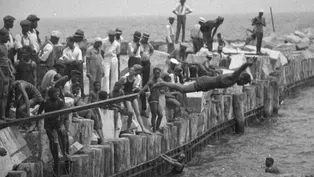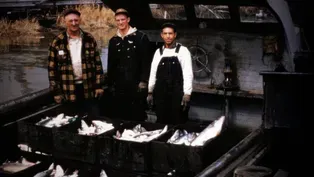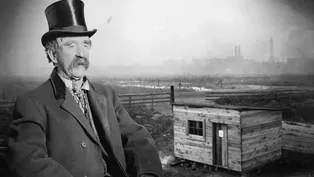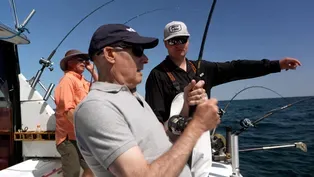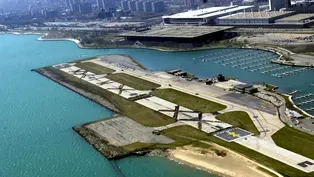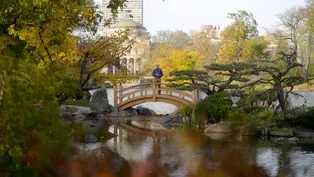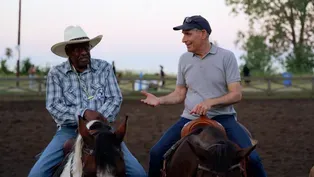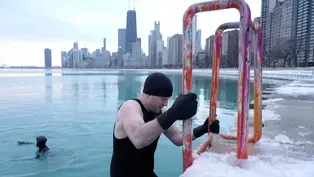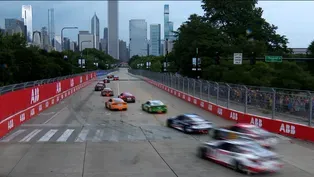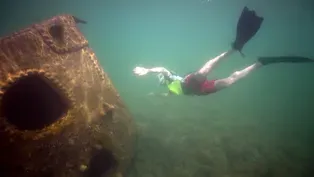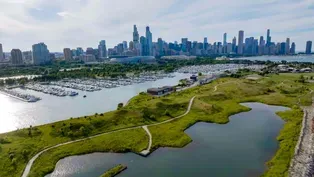
Grant Park: Forever Open, Clear, and Free
Clip: Special | 6m 42sVideo has Closed Captions
A. Montgomery Ward launched a legal battle to preserve the lakefront for the people.
Mail order magnate A. Montgomery Ward was outraged that the lakefront near present-day Grant Park (built in part from the ash from the Great Chicago Fire) was rife with shantytowns and garbage. He filed lawsuits to clear the area and prevent further construction. His lawyer leaned on a phrase from an old map – that this section of the lakefront should remain "forever open, clear, and free."
Problems with Closed Captions? Closed Captioning Feedback
Problems with Closed Captions? Closed Captioning Feedback
Chicago Tours with Geoffrey Baer is a local public television program presented by WTTW

Grant Park: Forever Open, Clear, and Free
Clip: Special | 6m 42sVideo has Closed Captions
Mail order magnate A. Montgomery Ward was outraged that the lakefront near present-day Grant Park (built in part from the ash from the Great Chicago Fire) was rife with shantytowns and garbage. He filed lawsuits to clear the area and prevent further construction. His lawyer leaned on a phrase from an old map – that this section of the lakefront should remain "forever open, clear, and free."
Problems with Closed Captions? Closed Captioning Feedback
How to Watch Chicago Tours with Geoffrey Baer
Chicago Tours with Geoffrey Baer is available to stream on pbs.org and the free PBS App, available on iPhone, Apple TV, Android TV, Android smartphones, Amazon Fire TV, Amazon Fire Tablet, Roku, Samsung Smart TV, and Vizio.
why is the site of his homestead a half mile from shore today?
Well, it's because this part of Chicago used to be under the surface of Lake Michigan.
Millennium Park?
Well, the Bean would've been a boat if it existed in the 1840s, because Michigan Avenue was lakefront property.
Even back then it was some of the ritziest real estate in Chicago.
It was called Terrace Row.
Now, in the summer, Terrace Row residents luxuriated in their cool lakefront breezes.
But come November, and angry winded waves threatened to wash it all away.
An estimated 20 acres of lakefront had vanished due to powerful waves and erosion.
The fledgling city desperately needed a breakwater to protect Terrace Row residents from Lake Michigan's wrath.
But who would pay for it?
The city saw an angle.
It allowed the Illinois Central Railroad to run its tracks right up the lakefront on a trestle about 100 yards offshore.
And in exchange, the railroad built a sea wall to protect the shoreline.
This early example of The Chicago Way left Terrace Row residents conflicted.
On the one hand, they didn't want their million dollar views spoiled by steam trains belching coal dust, but they didn't want their mansions floating away into the lake either.
Ultimately, the lakefront got railroaded.
(train horn blaring) Fast forward to the 1890s, the lake has been filled in between the shore and the tracks in part with ashes from the Great Chicago Fire creating a makeshift lakefront park.
And Terrace Row townhomes have been replaced by commercial buildings.
One of them is home to a booming mail order business founded by A. Montgomery Ward.
Ward had his offices and warehouse in this building right on Michigan Avenue.
He said he wanted his employees to have the light and fresh air of the lakefront.
But when he looked out his office window, what he saw made his blood boil.
He was appalled by garbage dumps, circuses, and shanty towns that littered what was then called Lake Park.
But Ward's lawyer found salvation in five words written on an old map.
In 1836, the canal commissioners who platted the city had declared that this part of the lakefront should remain, quote, "forever open, clear, and free of any buildings or other obstructions whatever."
For the next 20 years.
In lawsuit after lawsuit, Ward used those five words as a cudgel to clear away the clutter and beat back anyone who wanted to build on this part of the lakefront.
He said he did it for the poor people of Chicago, not the millionaires, but his legal victories cost him time, money, and friends.
Near the end of his life, Ward told the Chicago Tribune, "Had I known in 1890 how long it would take me to preserve a park for the people against their will, I doubt if I would have undertaken it."
(light playful music) Chicago's most famous lions aren't in the zoo.
They've been guarding the entrance to the Art Institute since 1894.
And have you ever noticed, they're not twins.
Artist Edward Kemeys said his northern lion is "on the prowl" and he gave the southern lion a look of "defiance" with eyes in the distance.
Now, if these guys could talk, maybe they could explain how the Art Institute escaped Montgomery Ward's lawsuits and ended up being built right in Lake Park.
The short answer is the museum got the consent of its neighbors.
But it probably didn't hurt that Montgomery Ward was on the Art Institute's board of trustees.
When he died, the museum said the, quote, "watchdog of the Lake Front was always a friend to the Art Institute."
Right, guys?
(lions roar) Lake Park was renamed Grant Park in 1901 to honor the Civil War General and US President.
And by now, it had grown from a narrow strip along the lakefront to 319 acres.
In 1927, Chicago turned on Buckingham Fountain inspired by the Latona Fountain of Versailles in France.
But Chicago's Rococo masterpiece is twice as big as Louis XIV's.
In fact, it's one of the biggest fountains in the world.
Buckingham Fountain sealed Grant Park's reputation as Chicago's front yard.
(bright music) (fountain shimmering) During the Democratic National Convention of 1968, that front yard ended up on front pages all across the country.
An estimated 10,000 protestors rallied in Grant Park united in opposition to the Vietnam War, much to the dismay of Chicago's powerful mayor, Richard J. Daley.
- The intention of these terrorists was openly displayed.
They came to Chicago to disrupt the national political convention and to paralyze our city.
- [Geoffrey] Their planned protest march barely made it out of Grant Park before police moved in.
(crowd yells) (tense music) The whole world was watching, and Grant Park became emblematic of 1960s' turbulence.
But 40 years later, fear and loathing in Grant Park was replaced with hope and change.
- [Crowd] Obama!
Obama!
(crowd cheers) - [Geoffrey] On November 4th, 2008, 200,000 people were there when the TV networks called it- (crowd cheers) And Chicago made history welcoming America's first African American president, Barack Obama.
(crowd cheers) - [Crowd] Yes, we can!
31st Street Beach and the Red Summer of 1919
Video has Closed Captions
Clip: Special | 4m 45s | Racial violence in Chicago first exploded at a lakefront beach during the Red Summer. (4m 45s)
Calumet Fisheries and the Legacy of Commercial Fishing
Video has Closed Captions
Clip: Special | 3m 51s | Calumet Fisheries is a rare survivor of Chicago’s commercial fishing days. (3m 51s)
The Con Man Who Staked a Claim on Streeterville
Video has Closed Captions
Clip: Special | 2m 3s | Chicago’s Streeterville neighborhood was once a seedy vice district. (2m 3s)
Video has Closed Captions
Clip: Special | 5m 52s | Geoffrey Baer embarks on a fishing trip on Lake Michigan. (5m 52s)
How Meigs Field Became Northerly Island (Again)
Video has Closed Captions
Clip: Special | 4m 34s | A former lakefront airport has become a green space once envisioned by Daniel Burnham. (4m 34s)
Jackson Park and The White City
Video has Closed Captions
Clip: Special | 2m 1s | Jackson Park was the site of the World’s Columbian Exposition. (2m 1s)
Jean Baptiste Point DuSable's Lakefront Homestead
Video has Closed Captions
Clip: Special | 3m 20s | Jean Baptiste Point DuSable built a homestead at the convergence of the river and lake. (3m 20s)
Video has Closed Captions
Clip: Special | 3m 44s | A horseback riding club teaches equestrian skills to a new generation. (3m 44s)
Meet Chicago's Winter Swimmers
Video has Closed Captions
Clip: Special | 4m 49s | Meet the swimmers who swim in Lake Michigan year-round – even in winter weather. (4m 49s)
The Montrose Beach Piping Plovers
Video has Closed Captions
Clip: Special | 4m 35s | Montrose Beach became a nesting site for piping plovers in 2019. (4m 35s)
The NASCAR Chicago Street Race
Video has Closed Captions
Clip: Special | 2m 56s | Geoffrey Baer visits the NASCAR Chicago Street Race. (2m 56s)
Video has Closed Captions
Clip: Special | 4m 44s | A shipwreck sits just 600 feet off Chicago’s lakefront on an ancient reef. (4m 44s)
The Surprising History of Promontory Point
Video has Closed Captions
Clip: Special | 1m 32s | Promontory Point is yet another example of Daniel Burnham’s Plan of Chicago. (1m 32s)
Touring Chicago's Lakefront Trailer
Video has Closed Captions
Preview: Special | 1m 1s | Preview Touring Chicago's Lakefront, combining history and shining light on contemporary challenges. (1m 1s)
Providing Support for PBS.org
Learn Moreabout PBS online sponsorshipSupport for PBS provided by:
Chicago Tours with Geoffrey Baer is a local public television program presented by WTTW
